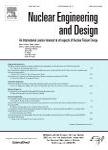版权所有:内蒙古大学图书馆 技术提供:维普资讯• 智图
内蒙古自治区呼和浩特市赛罕区大学西街235号 邮编: 010021

作者机构:Xi An Jiao Tong Univ State Key Lab Multiphase Flow Power Engn Dept Nucl Sci & Technol Xian 710049 Peoples R China Purdue Univ Sch Nucl Engn W Lafayette IN 47907 USA
出 版 物:《NUCLEAR ENGINEERING AND DESIGN》 (核工程与设计)
年 卷 期:2019年第343卷
页 面:1-10页
核心收录:
学科分类:08[工学] 0827[工学-核科学与技术]
基 金:National Natural Science Foundation of China [11575137 11605131]
主 题:Severe accident Hydrogen detonation Nitrogen inhibition effect Carbon monoxide
摘 要:Nitrogen inhibition is considered as a mitigation measure against chemically sensitive mixtures in industry and carbon monoxide is possibly generated during molten corium concrete interaction in a severe accident of nuclear power plants. To study the effects of the N-2 and CO on the detonation of H-2-air mixtures, a detonation facility of 78 mm inner diameter and 10 m length is set up. Key measured parameters includes detonation cell size, flame velocity, lean and rich detonation limits. All the measured detonation parameters are theoretically predicted by CJ theory or one-dimensional ZND model. Detailed chemical kinetics mechanism for H-2-air and H-2-CO-air mixtures is coupled with reactive Euler equations. Experiments and theoretically analysis has been performed mostly at 0.101 MPa and 293 K. Results shows that N-2 increases the detonation cell size and narrows down the detonable range significantly. Especially when N-2 concentration is more than 43%, all mixtures are unable to detonate. Moreover, when the added N-2 concentration is larger than 20%, detonation velocity does not increase with hydrogen concentration for rich mixtures. The above effects of N-2 is explained by the replacement of O-2 with N-2 and by the weak chemical reaction of N-2. CO significantly decreases the cell size of lean H-2-air mixtures and increased the cell size for rich H-2 -air mixtures. For lean H-2-air mixtures, the added CO linearly decreases the lean detonation limit, thus increasing the possibility of detonation to occur in the severe accidents. Therefore, the contribution of CO must be carefully considered in the safety assessment. Results also shows that pure CO is difficult to detonate in the air, while small quantity of hydrogen can significantly enhance the rate of CO oxidation reactions.